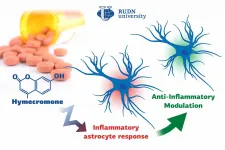(Press-News.org) A Mason Engineering researcher has discovered that artificial microswimmers accumulate where their speed is minimized, an idea that could have implications for improving the efficacy of targeted cancer therapy.
Jeff Moran, an assistant professor of mechanical engineering in the Volgenau School of Engineering, and colleagues from the University of Washington in Seattle studied self-propelled half-platinum/half-gold rods that "swim" in water using hydrogen peroxide as a fuel. The more peroxide there is, the faster the swimming; without peroxide in pure water, the rods don't swim.
In this work, they set out to understand what happens when these artificial microswimmers are placed in a fluid reservoir containing a gradient of hydrogen peroxide--lots of peroxide on one side, not much on the other side.
They found that, predictably, the microswimmers swam faster in regions with high peroxide concentration, says Moran, whose research was published in the new issue of Scientific Reports.
As others had observed, the direction of swimming varied randomly in time as the swimmers explored their surroundings. In contrast, in the low-concentration regions, the rods slowed down and accumulated in these regions over the course of a few minutes.
The results suggest a simple strategy to make microswimmers passively accumulate in specific regions, an idea that might have useful, practical applications, he says.
Swimming at the microscopic scale is a ubiquitous phenomenon in biology, Moran says. "Lots of cells and microorganisms, such as bacteria, can autonomously swim toward higher or lower concentrations of chemicals that benefit or harm the cell, respectively."
This behavior is called chemotaxis, and it's both common and important, he says. "For example, your immune cells use chemotaxis to detect and swim toward sites of injury, so they can initiate tissue repair."
Moran and colleagues, like others in the field, have long been curious whether artificial microswimmers can mimic cells by performing chemotaxis, continuously swimming toward higher chemical concentrations. Some had claimed that the platinum/gold rods, in particular, could swim autonomously toward peroxide-rich regions.
"We were skeptical of these claims since the rods aren't alive, and therefore they don't have the sensing and response capabilities that are necessary for cells to execute this behavior," he says.
"Instead, we found the opposite: the rods built up in the lower concentration regions. This is the opposite of what one would expect from chemotaxis," Moran says.
The researchers conducted computer simulations that predicted this and validated them with experiments, he says.
"We propose a simple explanation for this behavior: Wherever they are, the rods move in randomly varying directions, exploring their surroundings. When they get to a low-fuel region, they can't explore as vigorously. In a sense, they get trapped in their comfort zones," Moran says.
"Conversely, in the high-peroxide regions, they move at higher speeds and, because their direction is constantly changing, escape from these regions more often. Over time, the net result is that rods accumulate in low-concentration regions," he says. "They don't have any intelligence. They end up where their mobility is the lowest."
Moran says this research is promising from a technical standpoint because it suggests a new strategy to make chemicals accumulate in a highly acidic area.
"Due to their abnormal metabolic processes, cancer cells cause their immediate surroundings to become acidic. These are the cells that need the most drugs because the acidic environment is known to promote metastasis and confer resistance to drugs. Thus, the cells in these regions are a major target of many cancer therapies."
Moran and colleagues are now designing microswimmers that move slowly in acidic regions and fast in neutral or basic regions. Through the mechanism they discovered here, they hypothesize that acid-dependent swimmers will accumulate and release their cargo preferentially where their speeds are minimized, namely the most acidic and hypoxic regions of the tumor, where the most problematic cells reside.
There is much more research to be conducted, but "these rods may have the ability to deliver chemotherapy drugs to the cancer cells that need them the most," Moran says.
"To be clear, our study doesn't prove that chemotaxis is impossible in artificial microswimmers, period; just that these particular microswimmers don't undergo chemotaxis.
"Instead, we've identified an elegantly simple method of causing unguided microswimmers to accumulate and deliver drugs to the most problematic cancer cells, which could have implications for the treatment of many cancers, as well as other diseases like fibrosis. We're excited to see where this goes."
INFORMATION:
People living with obesity tend to have unhealthy glucose and lipid levels in their blood, as well as high blood pressure. As a result, they are more at risk of cardiovascular and metabolic diseases. But scientists have observed that up to 45% of people living with obesity have healthy blood pressure and glucose and lipid levels, and therefore may not be at high risk of disease. The reason why this group of people with obesity remain healthy, has been poorly understood.
But now a team of researchers - led by scientists at the University of Copenhagen and Icahn School of Medicine ...
Biologists from RUDN University confirmed that a well-known spasmolytic drug called hymecromone can suppress the inflammatory response in astrocytes, important glial cells of the central nervous system. Potentially, it could be used to develop medications against Alzheimer's disease and other neurodegenerative conditions. The results of the study were published in the International Journal of Molecular Sciences.
All pathological processes in the nervous system, such as neurodegenerative diseases, injuries, or intoxications, are associated with inflammations. ...
An insecticide used to control pest infestations on squash and pumpkins significantly hinders the reproduction of ground-nesting bees -- valuable pollinators for many food crops, a new University of Guelph study has revealed.
This first-ever study of pesticide impacts on a ground-nesting bee in a real-world context found female hoary squash bees exposed to imidacloprid dug 85 per cent fewer nests, collected less pollen from crop flowers and produced 89 per cent fewer offspring than unexposed bees.
"Because they're not making nests and not collecting pollen, they cannot raise offspring," said Dr. Susan Willis Chan, a post-doc in the School of ...
Heart problems cause disturbed gene activity in the brain's memory center, from which cognitive deficits arise. Researchers at the German Center for Neurodegenerative Diseases (DZNE), the University Medical Center Göttingen (UMG) and the German Center for Cardiovascular Research (DZHK) come to this conclusion based on laboratory studies. They consider that they have found a possible cause for the increased risk of dementia in people with heart problems. In mice, a specific drug which is known to affect gene activity alleviated the mental deficits. The involved experts see these results as potential approaches for therapies. ...
HOUSTON - (Feb. 26, 2021) - Tracking the origin of synthetic genetic code has never been simple, but it can be done through bioinformatic or, increasingly, deep learning computational approaches.
Though the latter gets the lion's share of attention, new research by computer scientist Todd Treangen of Rice University's Brown School of Engineering is focused on whether sequence alignment and pan-genome-based methods can outperform recent deep learning approaches in this area.
"This is, in a sense, against the grain given that deep learning approaches have recently outperformed traditional approaches, such as BLAST," he said. "My goal with this study is to start a conversation about how to combine the expertise of both domains to achieve further improvements for this important computational ...
TORONTO, Feb. 26, 2021 - The maternal care of offspring is one of the behavioural drivers that has led some bee species to have an ever-expanding social life over the history of evolution, new research out of York University has found.
By virtue of being in a social group, the genome itself may respond by selecting more social rather than non-social genes. The behaviour and social environment come first, setting the stage for future molecular evolution.
In addition, the researchers have found that a similar genetic evolution happened independently in different species at different times, suggesting there is a unifying principle leading to the same social trait.
"There seems to be something about sociality specifically that is driving the genome to evolve in this way. It's a very ...
COLUMBIA, Mo. -- Marilyn Rantz still remembers the day she got the call that her mother, whose health had been declining, had fallen and fractured her shoulder. After rushing to the hospital, her mother told her she didn't understand how she ended up on a helicopter pad after the traumatic incident. A nearby nurse told Rantz the noise from the MRI scanning tube had caused her frightened mother to mistakenly believe she had been airlifted to the hospital on a helicopter.
Determined to prevent avoidable hospitalizations, as well as the stress and panic that often comes along with the ambulance ride, Rantz, ...
MEMPHIS, Tenn. - Extremely low birth weight (ELBW) infants with moderate to large patent ductus arteriosus (PDA) may benefit from transcatheter PDA closure (TCPC) in the first four weeks of life, according to research published by Le Bonheur Cardiologist Ranjit Philip, MD, and Medical Director of Interventional Cardiac Imaging and Interventional Catheterization Laboratory Shyam Sathanandam, MD. Early PDA closure may prevent early onset pulmonary vascular disease, promote growth and facilitate faster weaning off supplemental oxygen and ventilator support.
"The primary objective of this study was to describe changes in hemodynamics, ...
The National Cancer Institute's Genomic Data Commons (GDC), launched in 2016 by then-Vice President Joseph Biden and hosted at the University of Chicago, has become one of the largest and most widely used resources in cancer genomics, with more than 3.3 petabytes of data from more than 65 projects and over 84,000 anonymized patient cases, serving more than 50,000 unique users each month.
In new papers published Feb. 22 in Nature Communications and Nature Genetics, the UChicago-based research team shares new details about the GDC, which is funded by the National Cancer Institute (NCI), via subcontract with the Frederick National Laboratory for Cancer Research, currently operated by ...
Climate alone is not a driver for human behavior. The choices that people make in the face of changing conditions take place in a larger human context. And studies that combine insights from archaeologists and environmental scientists can offer more nuanced lessons about how people have responded -- sometimes successfully -- to long-term environmental changes.
One such study, from researchers at Washington University in St. Louis and the Chinese Academy of Sciences, shows that aridification in the central plains of China during the early Bronze Age did not cause population collapse, a result that highlights the importance of social ...





